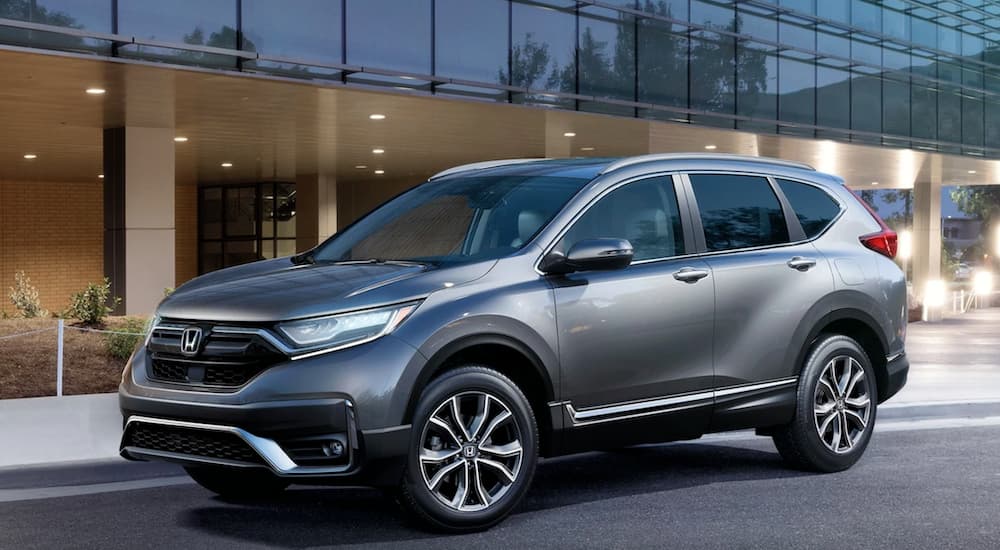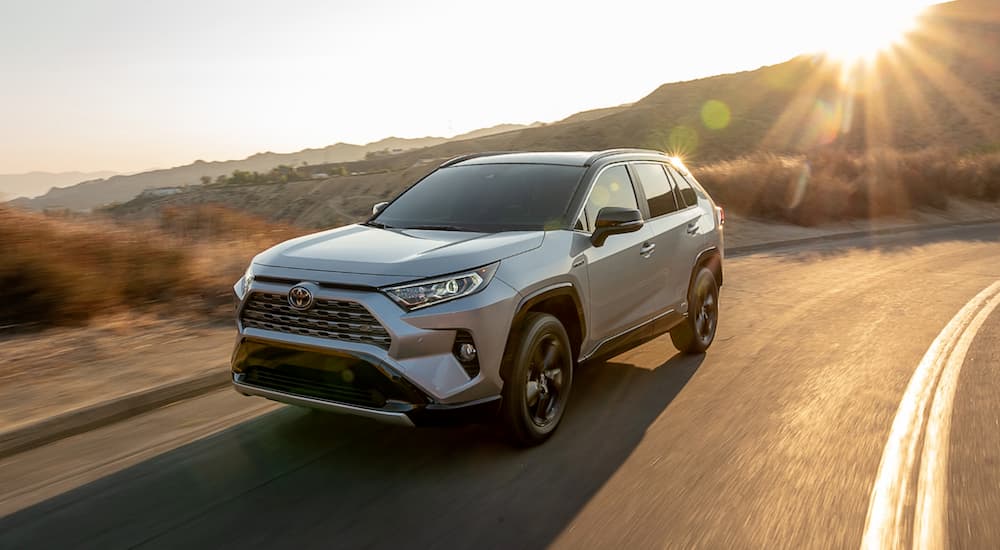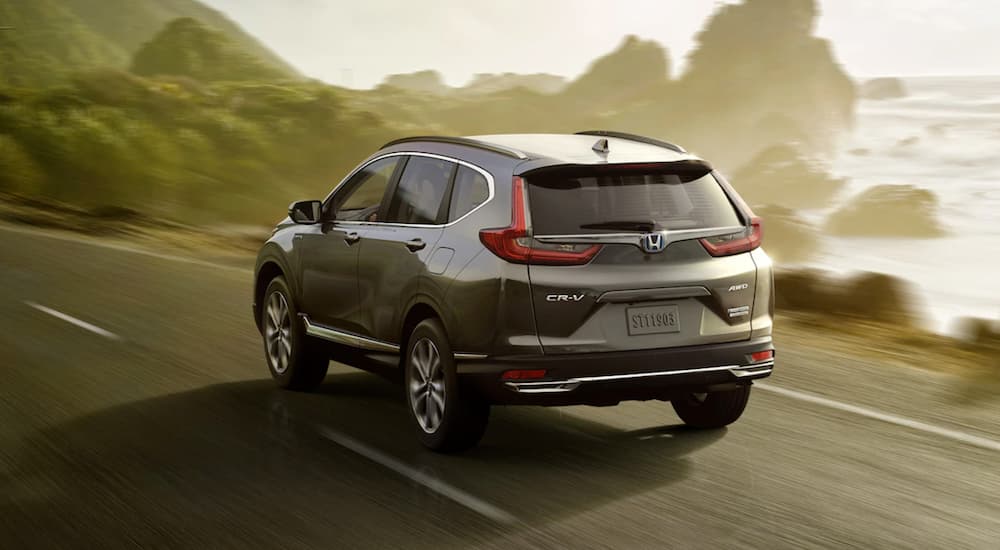Honda and Toyota have been tangling as top-selling manufacturers for a long time, and because many of their vehicles offer similar features and styles, they often end up battling for the same buyers. People who buy these brands typically want a vehicle that is fuel-efficient, offers a few conveniences, has useful safety features, and doesn’t cost too much. In other words, these buyers are thrifty, but they still want a decent ride that looks good. Compact SUVs are all the rage, and Honda and Toyota both offer their own version of a thrifty SUV with good fuel efficiency, but what do you get when you spring for the highest trim with the most features? Let’s compare the 2021 Honda CR-V vs the 2021 Toyota RAV4 to find out what your money will buy.
Trims and Pricing
Starting with Honda, the highest trim level available is the Touring. It has a starting MSRP of $33,650, which does not include any destination fees or added options. We would recommend adding the all-wheel drive for a little extra money, though. The Touring offers a long list of convenience and safety features. It comes standard with a moonroof, LED headlights, LED fog lights, roofline spoiler, rain-sensing wipers, and heated exterior mirrors. Fuel efficiency for the 1.5-liter turbocharged four-cylinder engine is 27 MPG in the city and 32 MPG on the highway with all-wheel drive.
In only a slight contrast, Toyota’s RAV4 Limited starts at $34,580 without added fees. Again, we would recommend paying the extra to get the available all-wheel drive. The exterior comes standard with LED headlights, LED fog lights, and heated exterior mirrors. The moonroof and rain-sensing wipers that are standard on the Honda are extra on the Toyota. It’s not a deal-breaker to have a moonroof or fancy windshield wipers, but it is a complaint of some Toyota buyers that the add-ons can get pricey, particularly in the upper trims. Fuel efficiency for the 2.5-liter four-cylinder engine is 27 MPG in the city and 34 MPG on the highway with the all-wheel drive.
Interior Space and Conveniences
Honda offers one of the roomiest compact SUVs in the segment, and that goes for both people and cargo when it comes to space. In the front, legroom is generous even for folks well over six feet at 41.3 inches, and in the back seat, it’s almost the same at 40.4 inches. That kind of space for rear passengers is often overlooked by too many manufacturers, but with the CR-V, you can taxi your tall friends anywhere you like. Cargo space is also extensive at 39.2 cubic feet in the rear trunk area, which is more than double what you get in a regular midsize sedan. With the seats folded down, that area expands to 75.8 cubic feet. Just in case that’s not enough space when you pack everything but the kitchen sink for vacation, the CR-V Touring has roof rails so you can toss extra equipment on the roof.
Toyota does well in its own right with space and isn’t far off from Honda’s CR-V. It does lag behind a little, with front legroom nearly equal at 41 inches and rear legroom behind at 37.8 inches. While the front seat isn’t likely to be noticed, the back seat passengers definitely have a little more space in the Honda. Cargo space behind the rear seats is 37.6 inches but only expands to 69.8 inches with the back seats folded down. That’s a significant difference against the Honda, even if you utilize the roof rails for extra luggage.
Space aside, the interior conveniences are similarly equipped with most of the technology buyers now expect, like Apple CarPlay, Android Auto, Bluetooth, and WiFi. Both the CR-V and the RAV4 have wireless phone charging and plenty of charging stations in front and rear, as well as navigation. There is no shortage of ways to be connected, stay charged, and use your devices hands-free. It comes down to little differences in convenience that could sway a person from one side to the other. For instance, if you live in a northern climate and have had the pleasure of enjoying a heated steering wheel, you may never want to go without it again. The CR-V Touring has a heated steering wheel to go with the standard heated front seats. Toyota has heated seats with the option of ventilation if you want to pay extra. No heated steering wheel.
Maybe that doesn’t matter to you if you live somewhere warmer, and you prefer the choice of ventilated seats. Honda also offers speed-sensitive volume, HD radio, and Pandora. Toyota does add Amazon Alexa, which is only great if you actually have an Alexa, not a Google Assistant. Either way, the match for the conveniences is fairly close and mostly depends on personal preference. Whichever one seems to fit your lifestyle needs is what you want to choose.
Safety Features
Both Honda and Toyota are well-known for their high safety ratings overall, and both the CR-V and the RAV4 come with an extensive list of driver-assisted safety features. While most new cars have at least a few advanced safety features, Honda and Toyota both have suites of features as standard equipment across all trims for these two SUVs. In the CR-V, Honda includes a suite of six features: collision mitigation, road departure mitigation, lane departure warning, forward collision warning, adaptive cruise control with low-speed follow, and lane-keeping assist. Additionally, the Touring adds automatic high beams and a blind spot information system with cross-traffic monitor.
Each of these features will automatically either alert the driver to potential danger, or the technology systems will brake or redirect the vehicle in case of potential impact or straying from the road. Aside from the adaptive cruise control, which just makes life easier because you no longer need to stop and start your cruise in traffic, each feature could be a life-saving technology. Toyota includes much of the same technology in its own suite of safety features, with a pre-collision system that detects pedestrians, lane departure alert with steering assist, automatic high beams, lane tracing assist, road sign assist, and full-speed radar cruise control.
Largely the difference between the two systems is the inclusion of Toyota’s road sign reading, while Honda’s cruise control will follow at slow speeds and offers a blind-spot monitor. Both vehicles have other onboard systems like auto emergency braking, rearview cameras, stability and traction control, and anti-lock brakes. Again, each of these vehicles is rated high for safety, and there is little difference between the two in terms of features.
It All Comes Down to Driving
Where the difference is most noticeable is in how the two vehicles drive. The 2021 Honda CR-V has been rated well among critics for the way the SUV handles and the comfort of the cabin on bumps. Honda took care to finely tune the continuous variable transmission so it would act more like the familiar automatic transmission most drivers know, which means the car will accelerate without clunky issues from the transmission. Toyota’s RAV4 has been accused of having trouble with slow acceleration and lackluster handling, meanwhile the price is higher for the same features you get on the Honda.
Before racing out to buy either SUV, it’s always wise to test drive and see the vehicle in person. You get a better sense of the interior space, how the steering feels when you corner, and whether or not the seats are comfortable enough to accommodate your expectations. Honda has an edge in terms of pricing, space, and a few extra features, but it also seems to have a more peppy engine and better handling. For the money, the 2021 Honda CR-V wins out this year.






